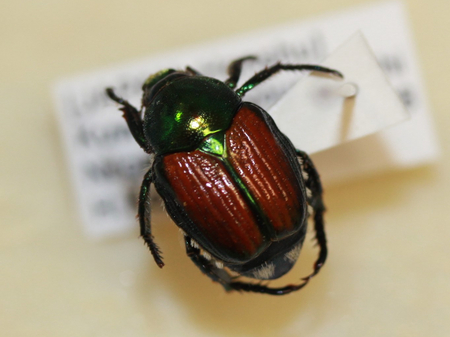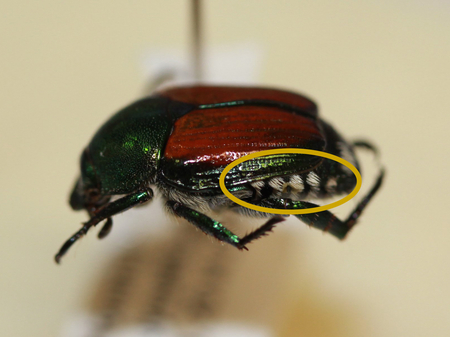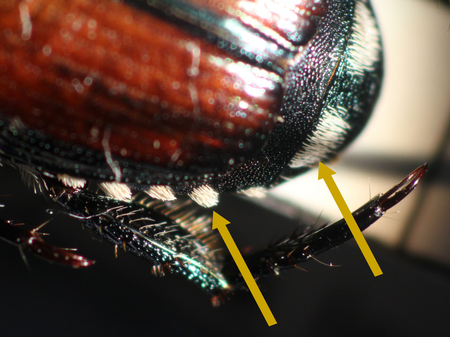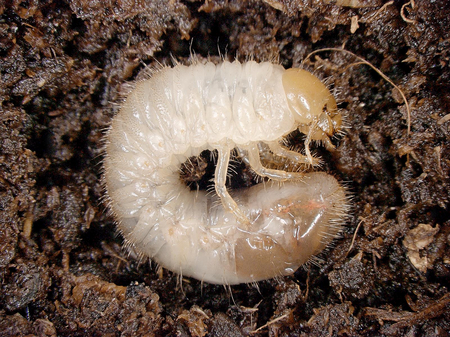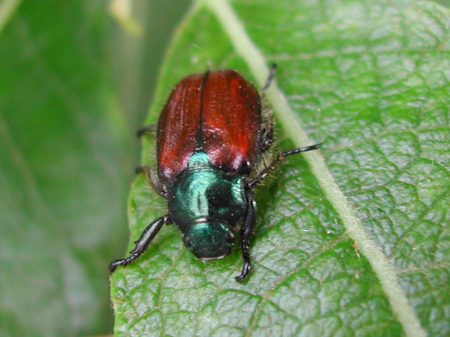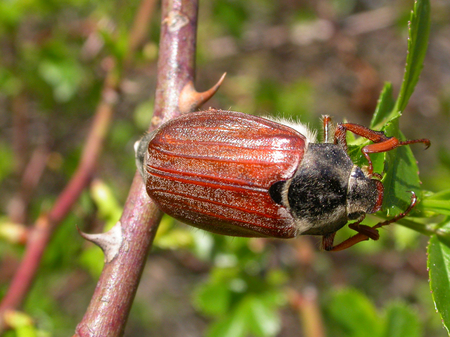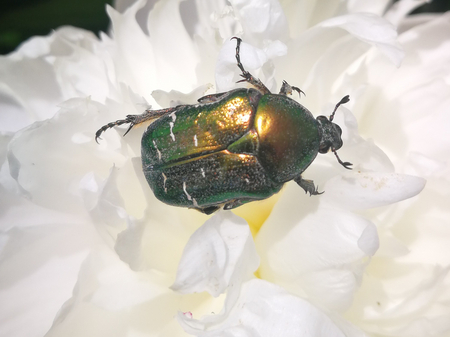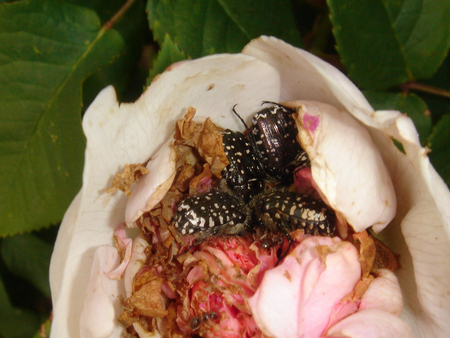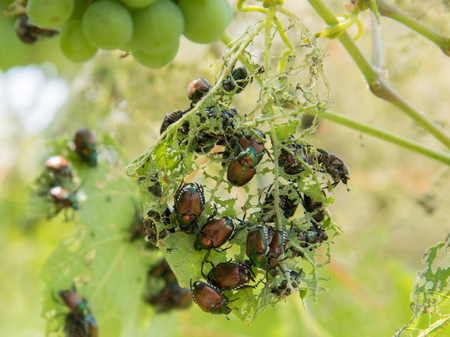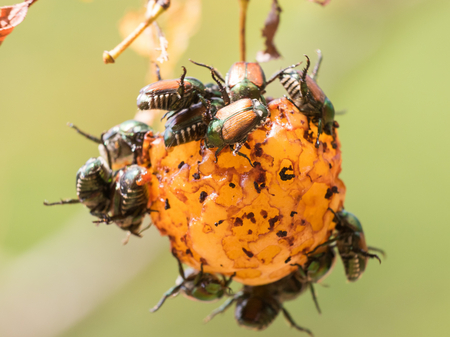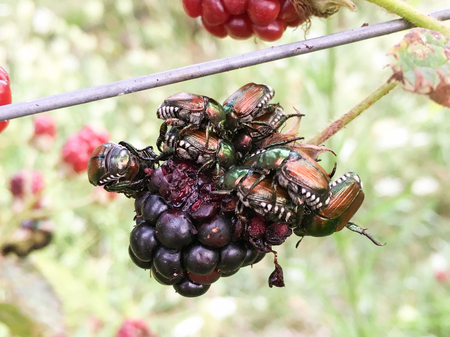Japanese beetle
Popillia japonica
Profile
The Japanese beetle can cause major damage to various plant species. It is listed as a priority quarantine pest in the EU and the presence of the beetle must be reported.
Current information
Report any suspicious beetle findings to us!
Help us to prevent the spread of a new plant pest in Austria in good time and make an important contribution to protecting our domestic agriculture. Please report suspicious beetle findings via the new AGES Japanese beetle reporting platform.
Japanese beetlereporting platform Possible confusions
Appearance
The Japanese beetle(Popillia japonica), a member of theScarabaeidae family, is approx. 10 mm long and 6 mm wide (Fig. 1). The head and thorax are metallic green in colour, the elytra are iridescent copper-coloured. The white tufts of hairs are striking, 5 on each side of the abdomen and an additional 2 tufts on the last abdominal segment (Figs. 2 and 3). The larvae have the shape of grubs and grow up to 30 mm in size. A clear identification of the larvae is only possible by microscopic examination, e.g. to recognise the V-shaped bristles on the last abdominal segment.
Possible confusion
The Japanese beetle can be confused with some other native leaf beetles, which differ from it in size, colouring, metallic sheen, tufts of hairs or other characteristics. There is a particular risk of confusion with the southern cereal leaf beetle(Anisoplia austriaca) (Fig. 5) and the garden leaf beetle(Phyllopertha horticola) (Fig. 7), but also with other species (Figs. 8 and 9), such as cockchafer (Fig. 10), June chafer and rose chafer (Figs. 11 and 12).
| Characteristic | Southern grain weevil | Japanese beetle | Garden leaf beetle |
|---|---|---|---|
| Tufts of hairs | no tufts of hairs, but dense, white hairs on the underside | 5 tufts of white hair on each side and 2 tufts of hair on the last abdominal segment | no hair tufts, but body finely hairy |
| Head and chest | black | green metallic iridescent | green metallic iridescent |
| elytra | brown coloured with/without black spot(s) around the scutellum; not hairy | copper-coloured iridescent with metallic green edge; not hairy | brown coloured and finely hairy |
| Size | 12-16 mm long | approx. 10 mm long and 6 mm wide | 8-11 mm long |
Table 1: The three species of leaf-horned beetles: the southern grain weevil, the Japanese beetle and the garden leaf beetle with the most important distinguishing features.
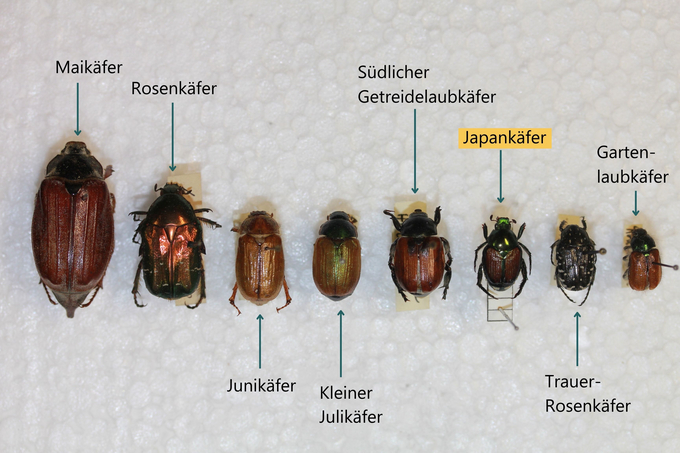
Biology
The Japanese beetle develops one generation per year. Depending on the climatic conditions, the beetles emerge from the ground in May/June, feed on leaves, flowers and fruit in several cycles and mate. The females lay 40 to 60 eggs in damp meadows and pastures. The eggs hatch into larvae, which live underground in the soil and feed on roots. The larvae overwinter in the third larval stage at a soil depth of approx. 15 to 30 cm. In spring, from an outside temperature of around + 10 °C, the larvae migrate back to the upper soil layers, where they continue to feed until they pupate and hatch after four to six weeks. The development cycle of the Japanese beetle thus lasts one year. In Austria, beetles can be expected from June to around mid-September.
Damage symptoms
The feeding activity of the beetles can be recognised on the above-ground parts of the plant (leaves, fruits, flowers). If they occur en masse, skeletal feeding can occur and the affected host plants can be stripped bare (Fig. 13). Many individuals can often be found together on one plant or fruit (Fig. 14, 15). The larvae of the beetles feed on the roots of grasses and herbaceous plants. This can cause grasses and/or herbaceous plants to die, resulting in browning of lawns or pastures.
Host plants
The host plant spectrum of the Japanese beetle is very wide and includes more than 400 plant species among trees, shrubs, wild plants and crops. The following host plants are particularly relevant for agriculture: Vine, apple, cherry, peach, apricot, plum, soft fruit, hazelnut, maize, soya bean, roses and many more. The Japanese beetle also feeds on deciduous trees such as maple, lime, elm and poplar. The larvae feed underground on the roots of grasses and herbaceous plants, both on grassland and meadows, such as well-maintained lawns (including golf courses), as well as on a variety of vegetables, garden and ornamental plants.
Distribution
The Japanese beetle originally comes from Japan and the Far East of Russia. Since the beginning of the 20th century, the beetle has been introduced to North America and Canada. In the 1970s, the Japanese beetle was introduced to Europe (Azores) for the first time, on the European mainland it was found for the first time in Italy (Lombardy) in 2014 and in Switzerland (Ticino, Basel area) in 2017. It is still widespread to a limited extent in both countries. In Germany (Baden-Württemberg), it was found in isolated traps in 2021, 2022 and 2023. New outbreaks occurred in summer 2023 near Zurich Airport and in Lignano (Friuli-Venezia Giulia region). In July 2024, a new outbreak was reported in Basel (CH) and traps were caught in Slovenia. A further spread of the Japanese beetle to neighbouring Germany and France is feared. No Japanese beetle has yet been found in Austria.
Spread
The Japanese beetle can spread in various ways. It can be spread unintentionally by any means of transport (e.g. car, train). Eggs, larvae and pupae can be transported with soil from infested areas to other areas through plant trade. The beetles themselves can also spread independently over short distances (approx. 500 to 1,000 metres per year), and with the help of the wind and increasing population density, they can also cover distances of several kilometres. The risk of the Japanese beetle settling in Central Europe is high due to the favourable climatic conditions and the availability of suitable food for the beetle. Extensive use of grassland and arable land favours the development of the beetle. Areas with predominantly coniferous or mixed forests are rather unsuitable.
Economic significance
If the Japanese beetle occurs en masse, considerable damage can be caused both by the beetles feeding on the above-ground parts of herbaceous and woody plants and by the larvae feeding on the roots in lawns and pastures. This can result in major crop losses and even the death of plants.
Prevention and control
The most important measure for preventing the spread of the Japanese beetle and its successful control is the early detection of its occurrence. This can be achieved through official monitoring measures and targeted controls. In Austria, the Federal Office for Food Safety carries out import inspections of host plants at points of first entry (e.g. at Vienna Airport), while the official plant protection services in the federal provinces check compliance with internal market regulations and are responsible for plant inspections.
In addition, a Japanese beetle reporting platform has been set up by AGES and the Official Plant Protection Service (APSD), where suspicious beetle findings can be reported, including important discovery data. These will be checked and identified by experts using uploaded photos.
Help us to prevent the spread of the Japanese beetle in good time and report any suspicious findings to us. This will make an important contribution to protecting our local agriculture.
If the Japanese beetle is found, the official plant protection service in the federal state concerned is responsible for taking measures.
Phytosanitary status
The Japanese beetle is listed as a priority quarantine pest in the EU, so the presence of the beetle must be reported.
Specialist information
Projects
EU-ERANET EUPHRESCO project MOMAPOJA: Methods for outbreak management of Popillia japonica in line with EU plant protection legislation, 01.06.2024 - 31.05.2026
EU-ERANET EUPHRESCO project EPIDISARTH: Improved knowledge about epidemiology and distribution of priority invasive and (re)emerging arthropod pests in fruit crops and grapevines (e.g. Aromia bungii, Popillia japonica, Halyomorpha halys), 01.03.2021 - 01.02.2023
Last updated: 13.02.2025
automatically translated
